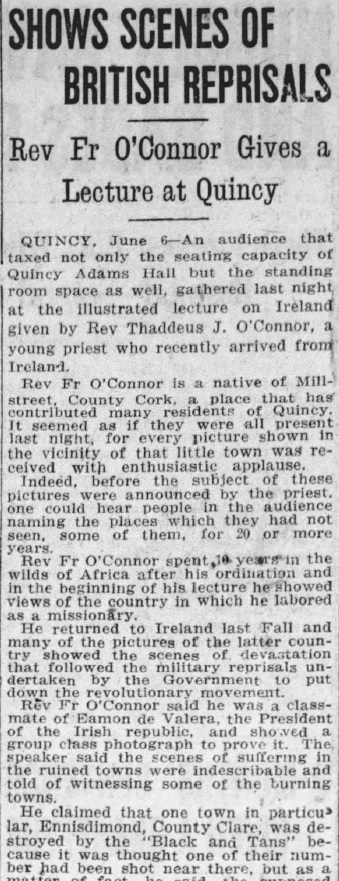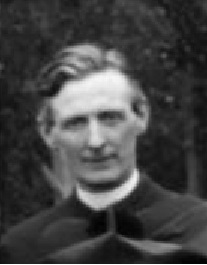

 O’CONNOR, Fr Thaddeus 1882-1959 Born 16 November 1882 in Millstreet, Co. Cork, Thady came to Rockwell as a boarder in 1898 where he was classmate of Edward Leen, ‘Red’ Mick O’Connor and John English. He joined the Juniorate when it was reopened 1900 and was prefect, 1902-6. He captained the 1904 Rockwell Munster Cup Team 1904 which included the Ryan Brothers, Jack and Mike – former internationals – Edward Leen, and Eamon de Valera. The doings of that team on and off the field were the source of unending anecdotes at reunions in later years and Thady featured in most of them because of his dashing and daring disposition. He did his novitiate in Prior Park, Bath, with Fr Tom O’Brien as novice master, and he then went on to France for his senior studies. Ordained in 1911 he received his obedience the following year for Nigeria.
O’CONNOR, Fr Thaddeus 1882-1959 Born 16 November 1882 in Millstreet, Co. Cork, Thady came to Rockwell as a boarder in 1898 where he was classmate of Edward Leen, ‘Red’ Mick O’Connor and John English. He joined the Juniorate when it was reopened 1900 and was prefect, 1902-6. He captained the 1904 Rockwell Munster Cup Team 1904 which included the Ryan Brothers, Jack and Mike – former internationals – Edward Leen, and Eamon de Valera. The doings of that team on and off the field were the source of unending anecdotes at reunions in later years and Thady featured in most of them because of his dashing and daring disposition. He did his novitiate in Prior Park, Bath, with Fr Tom O’Brien as novice master, and he then went on to France for his senior studies. Ordained in 1911 he received his obedience the following year for Nigeria.
His first appointment was to Holy Trinity, Onitsha-Waterside. He was called on by Fr Joseph Shanahan to launch the first training centre for teachers at Igbariam and he helped coach catechist Joe Delaney in philosophy and theology in preparation for his ordination in 1920. By then Fr Thady had been invalided home to Ireland, but as he recuperated at Blackrock he got actively involved in promotion work for Nigeria, giving illustrated lectures using the slides made with the assistance of Fr Jim Burke, who had coached him in this an when they were together in the senior scholasticate in Chevilly. He helped organise the Missionary Exhibition during the ‘Donnybrook Fair’ held at Blackrock in 1919, and was at hand to help organise Fr Joseph Shanhan’s appointments during the months when he had to undergo serious surgery. In particular, Fr Thady supplemented Shanahan’s addresses to the students in Maynooth using his slide projector to good advantage. Though active in making the arrangements for Bishop Shanahan’s team as they set out for Nigeria late 1920 he found himself still unable to travel with them. At Shanahan’s suggestion Fr Edward Leen was invited to replace him. Fr Thady continued his work on the Promotions team at home and for a period joined the Mission Band in the USA but, once he was allowed by doctors to return to his mission, he set out for Nigeria in September 1923. He served for periods at Emekuku and Port Harcourt. It was generally agreed that he was no longer capable of serving in the tropics. Forced to return home once more, he had to undergo several operations. When he was sufficiently recovered he returned to his alma mater, Rockwell, as professor of chemistry, a post he held till his death in spite of recurring ill health. A dynamic personality and a most obliging confrere he was highly respected by his students as ” a great character but one who would take no nonsense when it was a time for work. He retained his sense of humour, his lively gait and alert intellect to the end, and when the end did come, it came unexpectedly as he was staying with his retired sisters in Millstreet, Cork. Fr Thaddeus O’Connor died 14 August 1959 aged 76 years. He was buried in Rockwell. He was an uncle of Fr Frank Mulloy CSSp. GenArch. Nigeria; RCA 1960, 79; Farragher, Den and his Alma Mater, 73ff. – Irish Spiritans Remembered
=============
Thaddeus Joseph O’Connor was born at Coomlogane Streeet (West End) on November 16th 1882 to Thaddeus O’Connor (clerk of the Millstreet Union) and Hanoria Hickey. He was baptised the following day in Millstreet Church. [birth] [baptism].
His parents, two brothers and four sisters appear in the 1901 census still at Coomlogane Street, and his father is still the Clerk of the Union.
The family are still there in the 1911 census, but his father Thaddeus had died in 1905. Of their 11 children, 10 are still living.
His death cert contradicts his profile above, yes saying that he died on 14 August 1959, but that he died at St. Joseph’s Hospital, Clonmel, and not in Millstreet. [death]
=============
SHOWS SCENES OF BRITISH REPRISALS
Rev Fr O’Connor Gives a Lecture at Quincy
QUINCY, June 6—An audience that taxed not only the seating capacity of Quincy Adams Hall but the standing room space as well, gathered last night at the illustrated lecture on Ireland given by Rev. Thaddeus J. O’Connor, a young priest who recently arrived from Ireland.
Rev Fr O’Connor is a native of Millstreet, County Cork, a place that has contributed many residents of Quincy. It seemed as if they were all present last night, for every picture shown in the vicinity of that little town was received with enthusiastic applause.
Indeed, before the subject of these pictures were announced by the priest, one could hear people in the audience naming the places which they had not seen, some of them, for 20 or more years.
Rev. Fr. O’Connor spent 10 years in the wilds of Africa after his ordination and in the beginning of his lecture he showed views of the country in which he laboured as a missionary. He returned to Ireland last Fall and many of the pictures of the latter country showed the scenes of devastation that followed the Military reprisals undertaken by the Government to put down the revolutionary movement.
Rev Fr O’Connor said he was a class-mate of Eamon de Valera, the President, of the Irish republic, and shoved a group class photograph to prove it. The speaker said the scenes of suffering in the ruined towns were indescribable and told of witnessing some of the burning towns.
He claimed that one town in particularly, Ennisdimond, County Clare, was destroyed by the “Black and Tans” because it was thought one of their number had been shot near there, but as a matter of fact, he said, the supposed dead man showed up after the town was wrecked. Flame throwers, such as were used by the Germans during the World War. were now being used to destroy buildings, Rev Fr O’Connor said.
The speaker showed the ruins of Balbriggan, Mallow, Fermoy and Cork, and also the part of Dublin that has been the scene of so many street battles between the Crown forces and the Republican army.
Rev Fr O’Connor said that the stories circulated to the effect that Ireland did not contribute her share of soldiers to the World War were untrue. Be-tween 1914 and 1918, he said, more than 200,000 Irishmen volunteered for services in the British Army, to help destroy militarism and guarantee to small Nations their right to rule themselves.
Nearly every small Nation in Europe was given this right, he said, and some new Nations were brought into being to enjoy these privileges, but it remained for Ireland alone to have the militarism she fought against transferred into her own precincts and her right to self-government denied.
Many of the pictures shown were of places in Ireland not generally reached by the tourist, and others were scenes of the present-day activities, showing the army in action with its tanks and armoured cars, as well as the crowds of people kneeling outside the jails while young Irishmen were being hanged inside for taking part in the uprisings.
Rev Fr O’Connor ventured the opinion that the people of Ireland would not now accept any compromise outside of independence. He said the sufferings from the destruction of towns and industries during the reprisals were something terrible and said one of those who was doing great work in trying to alleviate these conditions was the sister of Lord John French, a former Lord Lieutenant of Ireland. During the evening there were,vocal solos by Cornelius M. Duggan and Charles Fay and the meeting closed with the singing of “America.”
(Quincy is just south of Boston, Massachusetts, U.S.A)
=============
With thanks to Bridget who sent us the newspaper article on the lecture in Quincy
